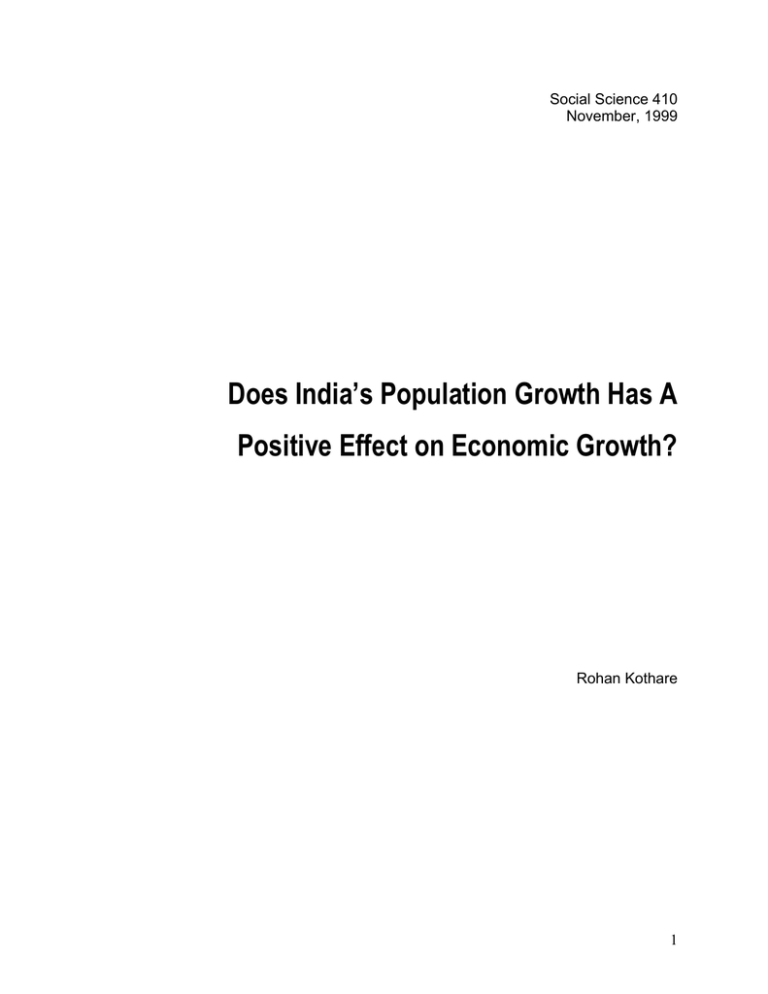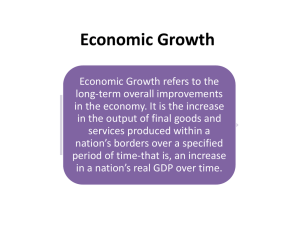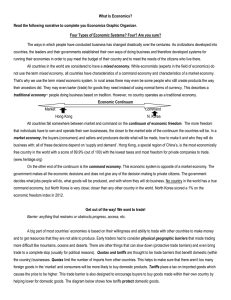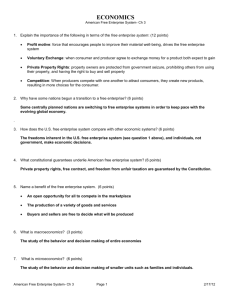Does India’s Population Growth Has A Positive Effect on Economic Growth?
advertisement

Social Science 410
November, 1999
Does India’s Population Growth Has A
Positive Effect on Economic Growth?
Rohan Kothare
1
Overpopulation is a growing problem throughout the world at this stage in time.
Currently, the world population has crossed over the six billion mark and is on an exponential
path upwards. Yet, what does this do to the status of nations’ economies? Economists are torn
between two theories; one that states population increase and growth help a nation’s economy
by stimulating economic growth and development and another that bases its theory on Robert
Malthus’ findings. Malthus states that population increase is detrimental to a nation’s economy
due to a variety of problems caused by the growth. For example, overpopulation and population
growth places a tremendous amount of pressure on natural resources, which result in a chain
reaction of problems as the nation grows. On the macroeconomic level, it is more believable to
argue that population does undermine a nation’s economy because an increase in the number
of people leads to an increase of the number of mouths to feed. The increase in demand for
food leads to a decrease in natural resources, which are needed for a nation to survive. Other
negative effects of population growth and, specifically, overpopulation include poverty caused
by low income per capita, famine, and disease. India is a prime example of Thomas Malthus’
theory of population growth and its effect on the economy. India is a country plagued by poverty
primarily caused by overpopulation. Inhabited by over nine hundred billion people, India has a
population of three hundred million under the poverty line. A majority of the poor population is
unemployed, starving, and is being forced to beg on the streets to make ends meet. Yet, the
government isn’t showing any apparent signs of reform to decrease poverty among their
citizens, through welfare programs or fiscal spending. In theory, more people may mean a
country can produce and consume more goods and services, leading to economic growth. But
this can only occur when employment opportunities grow at least as fast as the labor force and
when people have access to the necessary education and training. This is a race that the Indian
government is losing. Rapid population growth complicates the task of providing and
maintaining the infrastructure, education and health care needed by modern economies.
2
Economists advocating the positive side to population growth, say that the growth creates new
problems that in the short run constitute to a number of problems, including famine, poverty and
even unemployment. Yet, they also state that in the long run, it leads to new developments,
through advancement in technology, that leave countries better off than if the problems never
occurred. On one hand, theoretical elements suggest that more population retard the growth
output per worker. The overwhelming element in the theory is Malthusian diminishing returns to
labor, as the stock of capital does not increase in the same proportion as does labor.
On the positive side, one can see a chain reaction of events caused by population
growth. According to the neo-classical growth model, population is beneficial to an economy
due to the fact that population growth is correlated to technological advancement. Rising
population promotes the need for some sort of technological change in order to meet the rising
demands for certain goods and services. With the increased populace, economies are blessed
with a large labor force, making it cheaper as well, due to its immense availability. An increase
in labor availability and a low cost for labor results in a huge rise in employment as businesses
are more inclined to the cheap labor. Low labor costs results in a shift of money usage from
wages into advancement through technology. According to this model, the technological
advancement that accompanies the growth of population and the expansion of population,
allows for even more population to survive due to the rise in overall outputs by the business and
the nation as a whole. Thus, it generates demands for goods and results in overall economic
growth. The rising population provides a supply of labor and contributes to the increase in
output of goods. As shown in Graph 1, technological advancements allow for a rise in output
from Q to Q’. The rise in total output meets the demands of consumers and the demands as the
population keeps rising. Thus, the increase in output generally raises the per capita income of a
nation.
According to Julian Simon, a prestigious economist at the University of Maryland, the
long run benefits of population growth that links to economic development of poor countries are
3
on the positive balance, contrary to conventional wisdom. He figured that an increase in the
numbers of consumers and an increase of income, expand the demand for raw materials as
well as finished products. Naturally this would lead to a shortage in goods and services caused
by the high demand for products and services, forcing up prices for the natural resources. The
increased prices will trigger a search for new ways to satisfy the increasing demands in order to
meet expectations. Sooner or later new sources and innovative substitutes will be found. The
new discoveries lead to cheaper natural resources than existed before the increase in
population and the demand for goods and services begin. In turn, it leaves a nation better off
than if the shortages had never appeared, meaning the nation has gone through a process of
economic growth and development.
Normally, through conventional wisdom, economists might argue that population growth
and overpopulation hinders the growth output per worker. The important factor to this theory is
Malthusian diminishing returns to labor, as the stock of capital, including land, does not increase
in the same proportion as does labor. Another important factor, that contradicts Simon’s theory,
is the dependency effect, which suggests that saving is more difficult for households when there
are more children and that higher fertility causes social investment funds to be diverted away
from high-productivity uses. These factors seem to suggest that high fertility, and, more
importantly, increasing population growth create a negative effect on output per worker, and on
the broader aspect, it creates negative economic growth.
Yet, empirical data does not support this a priori reasoning. Contemporary evidence
provided by a number of economists indicates there is a correlation between population growth
and economic growth and development. Although most of these economists found inconsistent
evidence to prove this theory, they did, generally, obtain the same data. Their reports concluded
that population growth does have a positive effect on less-developed countries (LDC’s).
Although some said the positive effects were very minimal and weak, the economists were still
able to use a simulation model for LDC’s and report that economic growth did occur.
4
Economists, Easterlin, Kuznets, Conlisk and Huddle, and Thirlwall all arrayed LDC’s by
their recent population growth rates and their economic growth rates, to examine for
relationships between the two. Easterlin assessed that "[his data] is clear…that there is little
evidence of any significant, negative association between the income and population growth
rates. Kuznets compiled data on 21 countries in Asia and Africa, including India. In the samples
he took, Kuznets reported no significant negative correlation between population growth and the
growth per capita. Conlisk and Huddle regressed the output growth rate on the savings rate and
the rate of population growth of 25 LDC’s, and announced that an increment of population has,
ceteris paribus, a positive effect on per capita income. These empirical studies do not
necessarily show that fast population growth in less-developed countries increases capita per
income, although most findings reported positive effects. But they do imply that one should not
assert that population growth decreases per capita economic growth in less-developed
countries.
To prove this theory, put forth by
population economists, a model is
constructed that includes elements of the
standard LDC models but it also
embodies other elements: demand
effects on investment, work vs. leisure
choice, and variations in work activity as
a function of differences in needs and
standards of living and economics of
scale. It also embodies shifts in labor,
depreciation, and land building. The model solves the theory by utility maximization, or finding
the highest leisure-output indifference curve that touches the production function (Q = {L, T, K}).
Looking at Graph 2, one can see that production function, based on hours of work and total
5
output (Q), can reach maximum utility through maximizing employment (L), land (T) and capital
(K). Using a variety of parameters, the simulation indicates that positive population growth
produces considerable better economic performance in the long run, because maximum utility is
achieved with a high output, based on labor and land.
Other economists seem to think otherwise, and oppose the theory that population growth
has a positive effect on economic growth. Basic theory surrounding population growth in lessdeveloped countries states that the growth of a populace may eventually lead to overpopulation,
due to the simple factors of food, education, health, housing, and employment. Earth and its
resources are finite. Human ingenuity and efforts have limits to fulfill the needs of the increasing
numbers. The more heads there are in a nation means there are more mouths to feed. This
begins Malthus’ theory of diminishing returns when it comes to resources and food. Malthus
states: either people practice continence, restrain sexual impulses, or they breed themselves
into starvation. Population is said to be negative once productivity and output are less than
demand. Population growth, no matter how high or low it may be, results in a rise in a nation’s
populace. The rise in population will increase the demand for goods and services, such as food,
water, and a variety of other resources needed for survival. The demand indifference curve
shows us a primary problem with population growth. If supply (based on quantity and price)
ends up lower than the demand for the supply of the good, the resulting effect would be that of a
shortage of goods. In the long run, the resulting shortage of goods and services available to the
rising population leads to starvation. Yet, starvation isn’t achieved solely because of the
shortage in goods. Since demands are high for resources and the resources are depleted due
to the population increase, the prices of the goods are raised, causing a shift to the left in the
supply curve. The rising price, in return, reduces the demand for certain goods, unless the good
is a necessity for survival, causing a shift in the demand curve to the left. The decrease in
demand is due to the insufficient income per capita, meaning consumers cannot afford to
purchase many necessary goods in the market. Due to the fact that the goods are now
6
unaffordable the consumers won’t be able to purchase the necessary food required to survive,
resulting in starvation, famine and even disease.
Another problem associated with population growth, which might lead to a decrease in
economic growth, is the problem of environmental degradation and resource scarcity. Earth is
comprised of 75% water, the rest is comprised of land, with a majority of it used for agriculture.
According to Malthus, population growth of a nation is detrimental to economic growth, primarily
due to the factor of finite resources in an economy. With a rise in the number of people, a nation
can expect a decline in the natural resources and in the end a lowering of the production of
goods. In a closed and stagnant economy with fixed natural resources, no capital accumulation
and no technological change, population growth and size determines the standard of living as
well as the state of natural resources.
To some economists, rapid population growth can be associated with downward
pressure on wages and worsening distribution of income, if not actual negative effects on the
income per capita. This is mainly due to the spreading of capital over larger number of workers
or due to the difficulties in raising the quantity and quality of investments in education and
health. If it is true that continuous rapid population growth is detrimental to the growth of per
capita incomes, while past population growth is beneficial to the economy once fertility decline
sets in, then the ultimate impact of population growth on the environment depends on the
impact made by economic growth. Past population growth seemed to be at a slower rate than
what it is now, and because of that factor economic growth thrived in the past, where as now, it
seems that the rapid population growth is detrimental to an economy due to its strains on
resources, cause for famine, disease, poverty and even unemployment. This is why most
Malthusian economists urge governments to step up and curb the rapid population growth in
order to sustain economic growth.
Who is right, in asserting the positive or negative relations between population growth
and economic growth? In the case of India, one of the world’s most prosperous developing
7
nations, one can try to place India in the positive economic
growth theory, or the negative economic growth theory (Malthus’ theory).
India is considered a developing country, although it is one of the most affluent
developing countries in the world due to recent economic growth. Government reforms over the
past six years brought about an unprecedented strong economic performance. It grew at a rate
of over 5 percent in 1992-93 and 6 percent in 1993-94, and 7 percent in 1997. While the GDP
growth rates increase, India’s ranking over other nation’s GDP keeps climbing, to number 6,
behind countries like the US, Japan, China, Germany and other wealthy developed nations.
(See Figures 1, 2 and 3) Yet at a time of economic growth, India seems to be going through an
enormous population growth. Currently India has a population of over 900 million and just about
to reach the 1 billion mark. Although it may seem that India is overpopulated, statistics show
that the population growth rates have fallen over the years and reduced the rate of growth.
Table 2.1:Gross National Product,Net National Product,Per Capita
Income 1988-98
Gross
national product Gross
at factor cost
Domestic
product
Year (Rs bn)
to
at mkt
At
At
1980- price
current
(Rs bn)
81
prices
prices
Net national
product
at factor cost
(Rs bn)
At
current
prices
At
198081
prices
Per capita net
product
(Rs)
At
current
prices
At
198081
prices
8
19883482.1
89
1852.3 3957.8
3092.9
1657.5 3842.1
2059.0
19894029.3
90
1980.8 4568.2
3572.9
1773.2 4346.5
2157.1
19904702.7
91
2084.8 5355.3
4180.7
1864.5 4983.0
2222.2
19915426.9
92
2096.2 6168.0
4796.1
1861.9 5602.9
2175.1
19926189.7
93
2204.6 7059.2
5460.2
1956.0 6261.7
2243.1
19937205.3
94
2340.9 8107.5
6389.8
2075.5 7195.7
2337.2
19948549.4
95
2523.2 9634.9
7596.0
2235.8 8402.6
2473.2
19959928.0
96
2709.9 11189.6 8812.2
2399.6 9578.4
2608.2
199611353.7 2918.8 12769.7 10081.9 2584.7 10771.2 2761.4
97
199712602.6 3070.0 14150.0 11291.7 2718.5 11934.5 2871.9
98
(E)
Still, overpopulation is a problem in India and has been addressed by many
organizations: UNFPA, and the Population Summit, and more. According United Nations, India’s
population has gone from 348 million in 1950 to 850 million in 1990 to 950 million in 1998.
According to this data India’s population is increasing at an average rate of 2% a year, and is
gradually slowing down. The problems addressed by the United Nations, that accompany high
populations, are poverty and famine. In a population of 900 million almost 300 million are under
the poverty line, plagued by malnutrition, illiteracy, and social inequalities.
Table 1.1 : Indian demographics : A snapshot
Unit
1971
1981
CAGR 1991
CAGR
Population
(m)
548.0
683.0
2.2
950.0
2.2
Density
(per
km2)
177.0
230.0
2.7
273.0
1.7
Persons per
household
(no)
5.5
5.6
0.2
5.5
(0.1)
Districts
(no)
360.0
412.0
1.4
466.0
1.2
9
Towns
(no)
2,590.0 3,378.0 2.7
3,768.0 1.1
Villages (inhabited) (000s)
576.0
579.0
0.1
627.0
0.8
Rural population
(m)
439.0
524.0
1.8
629.0
1.8
Urban population
(m)
109.0
159.0
3.8
218.0
3.2
Male population
(m)
284.0
353.0
2.2
439.0
2.2
Female population
(m)
264.0
330.0
2.3
407.0
2.1
Females per 1000
males
(no)
930.0
934.0
-
927.0
(0.1)
Workers
(m)
181.0
242.0
2.9
306.0
2.4
Male
(m)
145.0
179.0
2.1
219.0
2.0
Female
(m)
36.0
63.0
5.8
87.0
3.3
Birth rate
(per
1000)
41.2
37.2
-
32.5
-
Death rate
(per
1000)
19.0
15.0
-
11.4
-
Expectation of life
at birth
(yrs)
45.6
50.5
1.0
58.2
1.4
Male
(yrs)
46.4
50.9
0.9
57.7
1.3
Female
(yrs)
44.7
50.0
1.1
58.7
1.6
Literacy rate
(%)
34.5
43.6
-
52.2
-
Male
(%)
46.0
56.4
-
64.1
-
Female
(%)
22.0
29.8
-
39.3
-
India seems to still sustain economic growth and stability,
through growth in a variety of sectors, agriculture, industrial
and the financial structure. Looking at Figure 4 one can
see that India is still attaining its high rates of economic
growth despite the rise in population. This is due to the low
unemployment rates that attach itself to India’s economy.
India has an increasing rate of employment that averages
about 1.2% annually. Like its Asian neighbors, India has a
large skilled work force, which, unlike other Asian nations, is protected by politically
powerful unions. India also has an abundance of white-collar workers to further advance
10
the industrial and agricultural sector. According to Table 2.1 the agricultural industry,
which 70% of the population depend on, is rapidly growing. Some economists say that
because of India’s abundance of natural resources, it could feed the whole world for the
next 100 years with the increasing rate of population growth.
Table 2.1 : Summary production of major crops (m tons)
Year to
1970- 1980- 1990- 1991- 1992- 1993- 1994- 1995- 1996- 199771
81
91
92
93
94
95
96
97
98
Foodgrains 108.4 129.6 176.4 168.4 179.5 184.3 191.5 180.4 199.3 194.1
Karif
68.9
77.7
99.4
91.6
101.5 100.4 101.1 95.1
104.4 103.7
Rabi
39.5
51.9
77.0
76.8
78.0
94.9
Cereals
96.6
19.0
162.1 156.4 166.6 170.9 177.5 168.1 184.9 -
Karif
65.0
73.9
94.0
87.2
95.8
95.0
96.4
90.5
98.9
-
Rabi
31.6
45.1
68.1
69.2
70.8
75.9
81.1
77.6
86.0
-
Pulses
11.8
10.6
14.3
12.0
12.8
13.3
14.1
12.3
14.4
13.1
Karif
3.9
3.8
5.4
4.4
5.6
5.4
4.7
4.6
5.5
-
Rabi
7.9
6.8
8.9
7.6
7.2
7.9
9.4
7.7
8.9
-
Rice
42.2
53.6
74.3
74.7
72.9
80.3
81.8
77.0
81.3
83.5
Karif
39.5
50.1
66.3
66.4
65.3
70.7
72.6
67.9
71.4
-
Rabi
2.7
3.5
8.0
8.3
7.6
9.6
9.2
9.1
9.9
-
Wheat
23.8
36.3
55.1
55.7
57.2
59.8
65.8
62.1
69.3
66.4
Jowar
8.1
10.4
11.7
8.1
12.8
11.4
9.0
9.3
11.1
8.9
Karif
5.8
7.5
8.3
5.7
9.4
7.3
5.9
5.6
7.0
-
Rabi
2.3
2.9
3.4
2.4
3.4
4.1
3.1
3.7
4.1
-
Maize
7.5
7.0
9.0
8.1
10.0
9.6
8.9
9.5
10.6
10.3
83.9
90.4
85.3
90.4
Industry has also grown enormously thanks to a large, skilled work force, even though
salaries remain relatively low. In Bangalore, the high-technology capital, a computer
programmer, with skills matching those of his peer in the United States, receives one-third the
salary. Paradoxically, the government has heavily subsidized higher education while neglecting
primary education. This accounts for the proportionally large number of professionals like
doctors, lawyers and engineers.
11
One may ask again, is India benefiting from their massive population and rising
population growth? Yes, India’s economy, no doubt, is achieving positive balance of results from
their population growth. Although one cannot say that India’s population has a 100% positive
effect on economic growth, but one may say that India is certainly profiting from an enormous
population.
Following the neo-classical growth model, India has advanced as a result of population
growth. According to Figure 2 India’s GDP has increased at a steady rate and is ranked among
the top among developing countries for their high rates of GDP and their steady increase of
output and wealth. Yet, looking at India’s GDP versus its population, in no way explains why
population growth has a positive effect on India’s striving economy.
A variety of factors play into the models that depict India’s growing economy. Due to the
rising population a large labor force is thus created. Yet the labor force never arrived from thin
air. Through Indian fiscal policies, India was able to spend money on education to instruct the
youth and adults, in order to help them play a productive role in India’s economy. Due to the rise
in the education among citizen’s, India was able to generate a high employment field. The high
rates of employment meant that India’s economic sectors, mainly agriculture and industry,
began increasing their productivity. Increase in productivity thus meant an increase in the output
of goods and services. This meant that the nation could now meet demands of the rising
population without having to raise prices, making necessities affordable to the poor. The Indian
Government acknowledged the high population growth of their nation, initiated fiscal policy on
education and thus expanded their frontier through a rise in productivity.
The increased output that the Indian Economy achieved created a rise in micro and
macro profits which would in turn lead to a rise in GDP. Through everything, India seemed to
defy many economists theories that rising population growth, in essence, is detrimental to a
nation. India, in fact, embraced the theories of Julian Simon, and used their disadvantage, or
even advantage to further expand their possibilities. Yet, there still is a rising problem in India
12
concerning poverty and malnutrition. But, through the theory that population growth has a
positive effect on economic growth, India will prosper in the long run.
In the end, India, has become one of the world’s fastest growing economies, primarily
due to the rise in population growth creating a positive effect on its long run economic growth.
India is now ranked one of the top producers in agriculture and is a top nation in terms of GDP
in a developing country. In many cases, economists are correct in saying that population growth
has a positive effect on economic growth of a nation. In reality, economists might say, "If it
weren’t for its high populations India would still be a suffering developing nation."
13
Bibliography
Simon, Julian. Population and Development in Poor Countries. Princeton: Princeton University
Press. 1992
Pringle, Simon. The Economic Growth Debate. New York : Franklin Watts Inc. 1978.
Riddell, Shackelford, Stamos. Economics: a tool for understanding society. New York : AddisonWesley. 1998
World Bank. India: Sustaining Rapid Economic Growth. Washington DC : World Bank. 1997
Kasun, Jaqueline. The War Against Population. San Francisco : Ignatius Press. 1988.
Cassen, Robert and Contributors. Population and Development: Old Debates, New
Conclusions. Washington DC : Overseas Development Council. 1994
Rostow, W. W. The Great Population Spike and After. Oxford : Oxford University Press. 1998
Royal Society, The. Population: The Complex Reality. UK : North American Press. 1994
BBC News. World: South Asia: India: The Economy.
http://news2.thls.bbc.co.uk/hi/english/world/south_asia/newsid_55000/55427.stm 1998
Government of India. The Indian Economy. 1997 http://www.nic.in/indiainfra/CHAP1.HTM
Annual Database. Indian Economy Database.
http://www.indiainfoline.com/econ/andb/pop/pop0.html 1998
Government of India Government Graphhs. http://www.nic.in/indiainfra/GRAPH1.HTM 1999
Unknown. Negative Ecological Impact of Overpopulation.
http://www.uia.org/uiademo/pro/d4007.htm 1997
14







